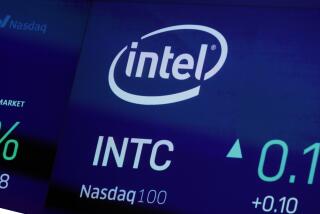Intel Cuts Sales Outlook, Citing Consumers
- Share via
Slowing consumer demand for high-tech gear prompted chip powerhouse Intel Corp. to reduce its sales forecast Thursday, sending the company’s shares lower in late trading.
The world’s largest computer chip maker, often viewed as a proxy for the overall health of the technology sector, said fiscal third-quarter revenue was likely to be $8.3 billion to $8.6 billion, down from its July forecast of $8.6 billion to $9.2 billion.
With softer demand for its computer processor and memory chips, Intel said its gross profit margin -- revenue minus the cost of goods sold, divided by sales -- would be about 58% for the quarter, off from its previous estimate of about 60%. The company offered no outlook for profit in the quarter ending Sept. 25.
“We’re seeing pretty uniformly around the world demand less than we expected: China, Europe, the Americas, somewhat in Japan,” Chief Financial Officer Andy Bryant said in a conference call with analysts after the markets closed. He attributed the “vast majority” of the downturn to consumers as opposed to business customers.
Intel shares, which had gained 20 cents to close at $21.63 during regular Nasdaq hours Thursday, fell 7.6% to $19.98 in extended trading.
The Santa Clara, Calif., company warned in July that its margins for the rest of the year would be tighter than previously projected, largely because sales have been concentrated among less-profitable products.
Higher-margin chips tend to include the microprocessors that are the brains of a computer, while lower-margin chips include semiconductors that simply control the flow of data.
“Demand is ... lower than expected” save for the lower-margin products, said Apjit Walia, an analyst in New York with RBC Capital Markets. “Desktop demand is down, and so is global semiconductor demand,” he added, noting a report earlier Thursday from the Semiconductor Industry Assn. that said computer chip sales growth in July had slowed.
During the last quarter, said Bryant, “we had economic indicators looking upward.... Today, the economic indicators aren’t looking as good.”
After a mediocre July and a weak August, Intel is hoping for a “typical” September, which would mean a boost from back-to-school sales. “Does September have to be extraordinarily big to meet our numbers? The answer is no,” Bryant said.
Most major personal computer makers that use Intel chips are preparing to release new, more powerful machines for the holiday shopping season, including PCs that play music and movies through home-entertainment systems. Such computers use more expensive Intel chips and will help increase profit, Walia said, but not “enough to really move the needle.”
Tai Nguyen, senior semiconductor analyst in San Francisco with Susquehanna Financial Group, said Intel was also suffering disappointing sales of flash memory chips, which retain data in cellphones, personal digital assistants and other gadgets.
Intel has nearly doubled, and sometimes more than doubled, its profit on a year-to-year basis for the last five quarters. Earnings should still be up in the third quarter -- even if revenue is at the low end of the estimate, $8.3 billion. The company earned $1.66 billion, or 25 cents a share, on revenue of $7.83 billion in the third quarter of 2003.
Before Intel’s announcement, Wall Street analysts surveyed by Thomson First Call had been expecting a profit of 30 cents a share on sales of $8.88 billion.
* (BEGIN TEXT OF INFOBOX)
Chipped stock
Intel shares, weekly closes and latest
Thursday after hours: $19.98
Source: Bloomberg News
***
Slower growth
Intel reduced its third-quarter sales forecast to between $8.3 billion and $8.6 billion. The midpoint of $8.45 billion is down from a previously estimated $8.9 billion.
Intel quarterly sales (In billions)
Q3 ‘04: $8.45*
*Midpoint of new estimated sales range of $8.3 billion to $8.6 billion
Source: Bloomberg News






